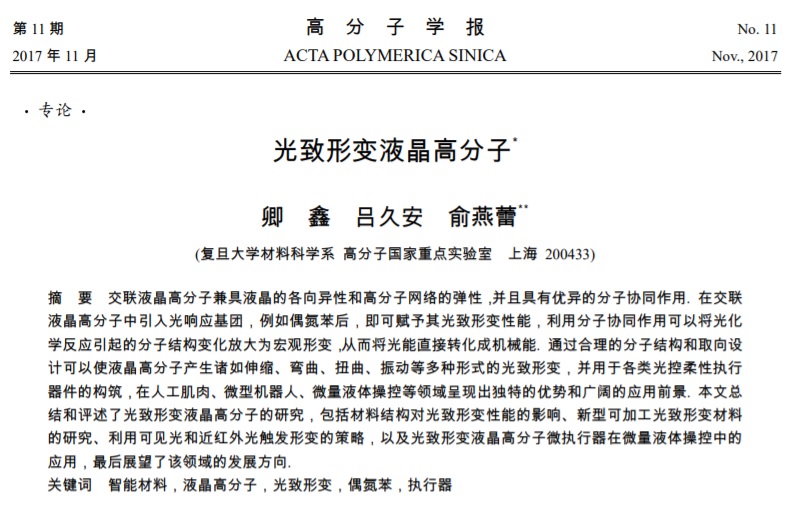Search
Title: Photodeformable Liquid Crystal Polymers
Author: Xin Qing, Jiu-an Lv, Yanlei Yu*
Journal: Acta Polymerica Sinica, 2017, (11), 1679-1705
Abstract:
As a combination of polymer networks and liquid crystals, cross-linked liquid crystal polymers (CLCPs) exhibit unique properties such as elasticity, anisotropy, self-assembly and molecular cooperation effect. The most important point is that the orientation of liquid crystal (LC) mesogens is strongly coupled with the conformation of polymer backbones, thus change of LC arrangement by stimuli will generate shape change of the whole sample. The macroscopic deformation of CLCPs is reversible because the initial alignment of mesogens is memorized by network. Light is a particularly ideal stimulus since it is a clean energy with wide range of sources and can be precisely and conveniently manipulated in terms of wavelength, intensity and polarization direction. Incorporation of photochromic moieties, such as azobenzene moieties, into CLCPs enables photodeformation of the samples. The reversibletrans-cis isomerization of azobenzenes upon specific light irradiation induces the change of LC order or LC director, and consequently leads to huge deformation of CLCPs. CLCPs containing azobenzene moieties can generate sophisticated movements including contraction/expansion, bending, oscillation and twisting, which directly convert photo energy into mechanical energy. Therefore, the photodeformable CLCPs are fabricated into various soft actuators by rational design, which brings about broad applications in artificial muscles, microrobots, microfluidics and so on. In this review, we mainly describe the development of azobenzene-containing CLCPs, and focus on the influence of molecular structures and alignment on the photodeformation behaviors. Started by introducing the mechanism of photodeformation involving photochemical phase transition and photoinduced reorientation, polyhydrosiloxane and polyacrylate CLCPs were described in details, with emphasis on the processable CLCPs and the novel methods to trigger deformation by visible light and infrared light. The applications of photodeformable CLCPs in the construction of diverse microscopic actuators ane microfluid manipulation are also described. An outlook of existing challenges and opportunities is also given at the end of this review.
Fulltext Link: http://www.gfzxb.org/thesisDetails#10.11777/j.issn1000-3304.2017.17196&graphicAbstract=0








